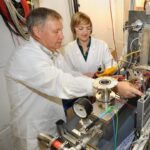Older Posts
Triply positive charged ions of the isotope Th-229 (Th3+) are of particular interest as the basis for a high-precision optical clock. ...

On 11 February 2024 Prof. Dr. Jens Volker Kratz passed away at the age of 79. He was a distinguished nuclear chemist, best known for his work in the field of the heaviest elements and was a former leader of our research group at GSI Darmstadt and at JGU Mainz. Photo: B. Kuczewski / private ...

Review in Nature Reviews Physics discusses major challenges in the field of superheavy elements and their nuclei and provides an outlook on future developments ...

Source of the photographic material: C. Düllmann (JGU/GSI/HIM) / G. Otto (GSI) The traditional annual TASCA Workshop on Recoil Separator for Superheavy Element Chemistry & Physics took place on April 25-27. This year’s workshop marked the 20th edition of the workshop series, which started in 2002. ...

The TASCA workshop will celebrate its twentieth anniversary in 2023! As in 2022, we will organize the TASCA workshop as a hybrid workshop. ...

Superheavy element 114 (flerovium) is a volatile metal An international research team has succeeded in gaining new insights into the chemical properties of the superheavy element flerovium - element 114 - at the accelerator facilities of the GSI Helmholtz Center for Heavy Ion Research in Darmstadt. The measurements show that flerovium is the most volatile metal in the periodic table. Flerovium is thus the heaviest element in the periodic table that has been chemically studied. ...
This year marks the 60th anniversary of the journal Radiochimica Acta, which was founded by Nobel Laureate Otto Hahn in 1962. ...

Source of the photographic material: C. Düllmann (JGU/GSI/HIM) / D. Dietzel (JGU) The traditional annual TASCA Workshop on Recoil Separator for Superheavy Element Chemistry & Physics took place on May 10-12, 2022. This year’s workshop marked the 20th anniversary of the workshop series, which started in 2002. ...
